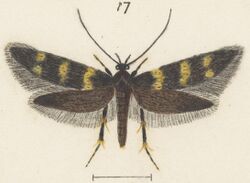Biology:Schiffermuelleria orthophanes
| Schiffermuelleria orthophanes | |
|---|---|

| |
| Illustration of male | |
| Scientific classification | |
| Kingdom: | |
| Phylum: | |
| Class: | |
| Order: | |
| Family: | |
| Genus: | |
| Species: | S. orthophanes
|
| Binomial name | |
| Schiffermuelleria orthophanes (Meyrick, 1905)[2]
| |
| Synonyms[3] | |
| |
Schiffermuelleria orthophanes is a moth of the family Oecophoridae. It is endemic to New Zealand. It is classified as critically endangered by the Department of Conservation.
Taxonomy
In 1905 Edward Meyrick described this species and named it Compsistis orthophanes.[4] He used specimens he collected in Nelson and Auckland in December and January.[4] The type specimen is held at the Natural History Museum, London.[3] Meyrick subsequently placed it within the European genus Schiffermuelleria with George Vernon Hudson discussing the species under this name in 1928.[5] This endemic New Zealand species likely belongs to a separate genus.[6] Robert J. B. Hoare has proposed a Hierodoris group to include this species but further work is needed to determine the correct genus in which to place this moth.[6] As such the species is currently also known as Schiffermuelleria (s.l.) orthophanes.[2]
Description
Meyrick described the species as follows:
9-10 mm. Head, antennae, and thorax dark bronzy-fuscous. Palpi rather dark fuscous, internally whitish-ochreous, terminal joint as long as second. Abdomen dark fuscous, apex whitish-ochreous. Fore-wings elongate, narrow, costa gently arched, apex round-pointed, termen very obliquely rounded ; fuscous, slightly purplish-tinged, irrorated with dark fuscous and blackish ; a straight rather narrow fascia at 1⁄4, a small spot in middle of disc, and opposite subcostal and subdorsal spots at 3⁄4 pale ochreous-yellow, irregular-edged : cilia fuscous, mixed with dark fuscous towards base. Hind-wings dark fuscous ; cilia fuscous, with dark fuscous basal shade.[4]
Distribution
This species is endemic to New Zealand.[2] It has been collected in Auckland,[4] Waimarino,[7] Wellington, North Brother Island, Stephens Island, Nelson, and Southland.[8]
Biology and habitat
Little is known of the biology of this species.[8] It has been hypothesised that larvae may subsist on litter or twigs.[8] The adult moths appear from September to March.[7] Hudson noted that, although previously regarded as rare, in the years surrounding 1928 the species had become more common.[7] Earlier records indicate the species inhabited modified and suburban localities.[5][7]
Conservation status
In 2017 this moth was classified under the New Zealand Threat Classification system as being Nationally Critical and data poor.[1]
References
- ↑ 1.0 1.1 Hoare, R.J.B.; Dugdale, J.S.; Edwards, E.D.; Gibbs, G.W.; Patrick, B.H.; Hitchmough, R.A.; Rolfe, J.R. (2017). Conservation status of New Zealand butterflies and moths (Lepidoptera), 2015. Wellington, New Zealand: New Zealand Department of Conservation. pp. 5. ISBN 9781988514383. http://www.doc.govt.nz/Documents/science-and-technical/nztcs20entire.pdf.
- ↑ 2.0 2.1 2.2 "Schiffermuelleria orthophanes (Meyrick, 1905)". Landcare Research New Zealand Ltd. http://www.nzor.org.nz/names/1dfffe01-a84e-4a17-a864-43b8777671ca.
- ↑ 3.0 3.1 Dugdale, J. S. (1988). "Lepidoptera - annotated catalogue, and keys to family-group taxa". Fauna of New Zealand 14: 98. https://www.landcareresearch.co.nz/__data/assets/pdf_file/0017/26324/FNZ14Dugdale1988.pdf. Retrieved 2 May 2018.
- ↑ 4.0 4.1 4.2 4.3 Meyrick, Edward (1905). "Notes on New Zealand Lepidoptera." (in en). Transactions of the Entomological Society of London 1905: 219–244. https://biodiversitylibrary.org/page/14788063.
- ↑ 5.0 5.1 Patrick, Brian; Dugdale, John S. (2000). Conservation status of the New Zealand Lepidoptera.. Wellington, New Zealand: Department of Conservation. pp. 28. ISBN 0478218672. http://www.doc.govt.nz/documents/science-and-technical/sfc136.pdf.
- ↑ 6.0 6.1 Hoare, Robert J. B. (2005). "Hierodoris (Insecta: Lepidoptera: Gelechioidea: Oecophoridae), and overview of Oecophoridae". Fauna of New Zealand (Lincoln, Canterbury, NZ.: Manaaki Whenua Press) 54: 1–102. ISSN 0111-5383. https://www.landcareresearch.co.nz/__data/assets/pdf_file/0017/26315/FNZ54Hoare2005.pdf. Retrieved 2 May 2018.
- ↑ 7.0 7.1 7.2 7.3 Hudson, G. V. (1928). The Butterflies and Moths of New Zealand. Wellington: Ferguson & Osborn Ltd.. pp. 260. http://www.bugz.org.nz/WebForms/ResultDetails.aspx?CurrentDoc=C7E94865-492F-45DA-9777-CC8E1E8B1438&back=true&NewDoc=true&searchType=1&SearchString=G.V.+Hudson.
- ↑ 8.0 8.1 8.2 Kerry-Jayne Wilson; Alastair Freeman (1993). A report on a visit to North Brother Island, Cook Strait, 6-11 February 1993. (Report). Lincoln University. p. 6.
Wikidata ☰ Q14318651 entry
 |


